上海中级口译教程第11章讲解
- 格式:ppt
- 大小:258.00 KB
- 文档页数:32
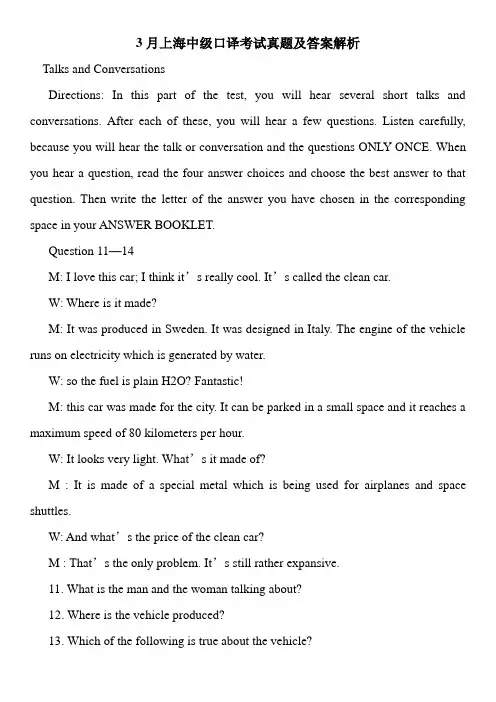
3月上海中级口译考试真题及答案解析Talks and ConversationsDirections: In this part of the test, you will hear several short talks and conversations. After each of these, you will hear a few questions. Listen carefully, because you will hear the talk or conversation and the questions ONLY ONCE. When you hear a question, read the four answer choices and choose the best answer to that question. Then write the letter of the answer you have chosen in the corresponding space in your ANSWER BOOKLET.Question 11—14M: I love this car; I think it’s really cool. It’s called the clean car.W: Where is it made?M: It was produced in Sweden. It was designed in Italy. The engine of the vehicle runs on electricity which is generated by water.W: so the fuel is plain H2O? Fantastic!M: this car was made for the city. It can be parked in a small space and it reaches a maximum speed of 80 kilometers per hour.W: It looks very light. What’s it made of?M : It is made of a special metal which is being used for airplanes and space shuttles.W: And what’s the price of the clean car?M : That’s the only problem. It’s still rather expansive.11. What is the man and the woman talking about?12. Where is the vehicle produced?13. Which of the following is true about the vehicle?14. What is the only problem with the vehicle?【解析】本对话讨论的是一种以新能源供能的汽车。

中级口译讲义(总6页)--本页仅作为文档封面,使用时请直接删除即可----内页可以根据需求调整合适字体及大小--中级口译讲义口试“政治类”:We established our friendly and cooperative relations on the understanding that we would develop our friendship on the basis of mutual respect and equality,and mutual benefit./We appreciate the interest and understanding that China has shown regarding the problems of small and developing countries./I look forward,in the next few days,to the opportunity of learning something from your experience on promoting economic and social development in the interest of your ,I wish to thank you for your very gracious and eloquent this very moment through the wonder of telecommunications,many people are hearing what we say today./We have a social and political system which differs in many respects from your is the result of different experiences and a different tradition./主席先生,我要感谢您那热情洋溢、雄辩无比的演讲。

1997.3上海市英语中级口译资格证书第一阶段考试参考答案:SECTION 1: LISTENING TESTPart A: Spot Diction1. like a rocket2. crew3. cargo-hold4. laboratory5. plan6. in advance7. every week 8. next9. convenience 10.immense opportunities11. reusable 12.space station13. piece by piece 14. for the rest15. commonplace 16. platforms17. solar system 18. developed and available19. technology 20. extensive programmesPart B: Listening Comprehension1-5 A A C A A 6-10 B B D B D11-15 A B D D D 16-20 B D A D C21-25 B C C D B 26-30 A D C A CPart C: Listening and TranslationⅠ.Sentence Translation1.纽约有一场大雾,我们在那里被耽搁了。
2.在中国逗留期间,我们希望了解能否在此开一家新德分支机构。
3.我希望下星期某个时候能与安妮会面。
星期一上午合适吗?4.如果你有合格德资历与经验,工资会略微高一点。
5.他刚开始工作后,发现(工作)比他期望的要困难得多。
Ⅱ.Passage Translation1.我是10年前到美国的,但我非常清楚地记得那一天。
飞机下午三点钟降落在肯尼迪机场时,我德朋友在迎候着我。
天气很冷,下着雪,我却兴奋,一点也不在乎。
2.从监狱里获释的人当中大约有七成迟早会再进监狱。
有些人认为这正说明了一个人一旦成为罪犯,九可能永远是罪犯。

Spot Dictation:We all have problems and barriers that block our progress, or prevent us from moving into new areas. Our problems might include the fear of speaking in front of a group, anxiety about math problems, or the reluctance to sound silly trying to speak a foreign language. It's natural to have problems and barriers, but sometimes they limit our experience so much, we get bored with life. When that happens, consider the following three ways of dealing with the problem or barrier.One way is to pretend it doesn't exist. Avoid it, deny it, and lie about it. It's like turning your head the other way, putting on a fake grin, and saying, "See, there's really no problem at all. Everything is fine."In addition to looking foolish, this approach leaves the barrier intact, and we keep bumping into it. So, a second approach is to fight the barrier, to struggle against it. This usually makes the barrier grow. It increases the barrier's magnitude. A person who is obsessed with weight might constantly worry about being fat. He might struggle with it every day, trying diet after diet. And the more he struggles, the bigger the problem gets.The third alternative is to love the barrier. Accept it. Totally experience it. Tell the truth about it. Describe it in detail.Applying this process is easier if you remember two ideas. First, loving aproblem is not necessarily the same as enjoying it. Love in this sense means total and unconditional acceptance. Second, unconditional acceptance is not the same as unconditional surrender. Accepting a problem is different than giving up or escaping from it. Rather, this process involves escaping into the problem, diving into it headfirst, and getting to know it in detail.Often the most effective solutions come, when we face a problem squarely, with eyes wide open, then we can move through the problem, instead of around it. When you are willing to love your problems, you drain them of much of their energy.【评析】本文选自Dave Ellis 旳著作Becoming a Master Student其中旳一种章节:Love your problems and experience your barriers,本文重要简介了处理问题旳三种措施,第一种是直接忽视它,就当不存在;第二种是正视它,挑战它,第三种则是爱上困难,充足体验。


3月上海中级口译考试真题及答案解析Talks and ConversationsDirections: In this part of the test, you will hear several short talks and conversations. After each of these, you will hear a few questions. Listen carefully, because you will hear the talk or conversation and the questions ONLY ONCE. When you hear a question, read the four answer choices and choose the best answer to that question. Then write the letter of the answer you have chosen in the corresponding space in your ANSWER BOOKLET.Question 11—14M: I love this car; I think it’s really cool. It’s called the clean car.W: Where is it made?M: It was produced in Sweden. It was designed in Italy. The engine of the vehicle runs on electricity which is generated by water.W: so the fuel is plain H2O? Fantastic!M: this car was made for the city. It can be parked in a small space and it reaches a maximum speed of 80 kilometers per hour.W: It looks very light. What’s it made of?M : It is made of a special metal which is being used for airplanes and space shuttles.W: And what’s the price of the clean car?M : That’s the only problem. It’s still rather expansive.11. What is the man and the woman talking about?12. Where is the vehicle produced?13. Which of the following is true about the vehicle?14. What is the only problem with the vehicle?【解析】本对话讨论的是一种以新能源供能的汽车。
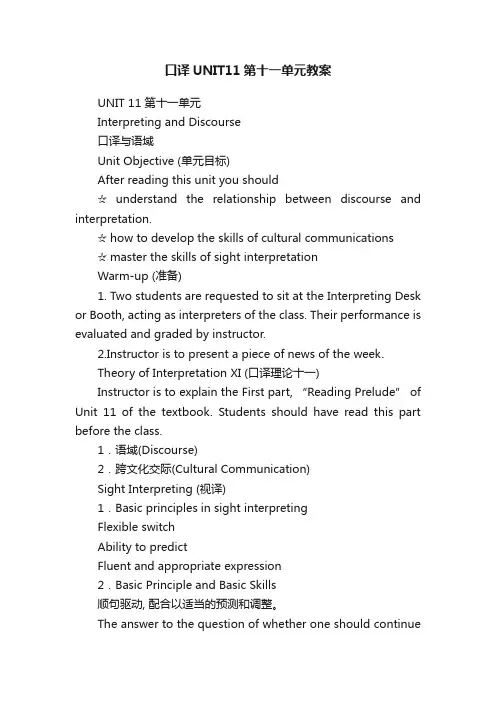
口译UNIT11第十一单元教案UNIT 11 第十一单元Interpreting and Discourse口译与语域Unit Objective (单元目标)After reading this unit you should☆ understand the relationship between discourse and interpretation.☆ how to develop the skills of cultural communications☆ master the skills of sight interpretationWarm-up (准备)1. Two students are requested to sit at the Interpreting Desk or Booth, acting as interpreters of the class. Their performance is evaluated and graded by instructor.2.Instructor is to present a piece of news of the week.Theory of Interpretation XI (口译理论十一)Instructor is to explain the First part, “Reading Prelude” of Unit 11 of the textbook. Students should have read this part before the class.1.语域(Discourse)2.跨文化交际(Cultural Communication)Sight Interpreting (视译)1.Basic principles in sight interpretingFlexible switchAbility to predictFluent and appropriate expression2.Basic Principle and Basic Skills顺句驱动, 配合以适当的预测和调整。
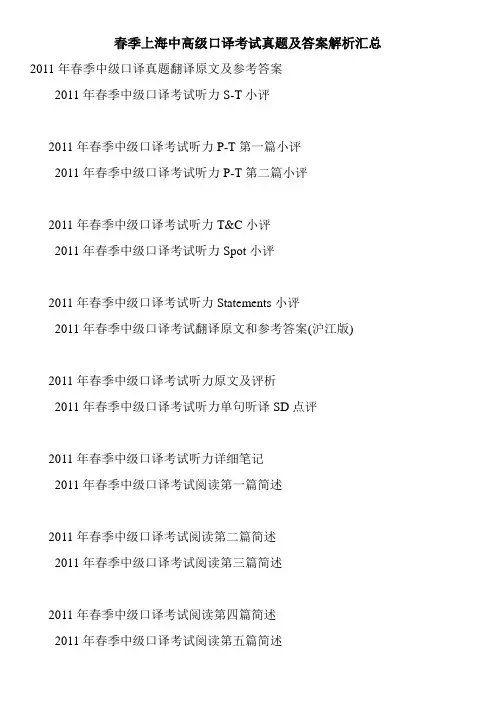
春季上海中高级口译考试真题及答案解析汇总2011年春季中级口译真题翻译原文及参考答案2011年春季中级口译考试听力S-T小评2011年春季中级口译考试听力P-T第一篇小评2011年春季中级口译考试听力P-T第二篇小评2011年春季中级口译考试听力T&C小评2011年春季中级口译考试听力Spot小评2011年春季中级口译考试听力Statements小评2011年春季中级口译考试翻译原文和参考答案(沪江版)2011年春季中级口译考试听力原文及评析2011年春季中级口译考试听力单句听译SD点评2011年春季中级口译考试听力详细笔记2011年春季中级口译考试阅读第一篇简述2011年春季中级口译考试阅读第二篇简述2011年春季中级口译考试阅读第三篇简述2011年春季中级口译考试阅读第四篇简述2011年春季中级口译考试阅读第五篇简述2011年春季中级口译考试阅读第六篇简述2011年春季上海高级口译考试真题及答案解析汇总1 2011年春季高级口译真题翻译原文及参考答案查看2 2011年3月高级口译听力Spot Dictation原文(昂立教育版) 查看3 2011年3月高级口译听力Spot Dictation原文(沪江) 查看4 2011年3月高级口译听力上半场第二部分原文(沪江) 查看5 2011年3月高级口译听力上半场第四篇原文(昂立教育版) 查看6 2011年3月高级口译句子听译原文和答案(沪江) 查看7 2011年3月高级口译段落听译原文和答案(沪江) 查看8 2011年3月高级口译阅读上半场第一篇原文(新东方版) 查看9 2011年3月高级口译阅读上半场第三篇原文(新东方版) 查看10 2011年3月高级口译阅读上半场第四篇原文(新东方版) 查看11 2011年3月高级口译翻译原文和参考答案(新东方版) 查看12 2011年3月高级口译阅读下半场第一篇原文及解析(新东方版) 查看13 2011年3月高级口译阅读下半场第二篇原文及解析(新东方版) 查看14 2011年3月高级口译翻译原文和参考答案(沪江版) 查看15 2011年3月高级口译英译汉的八大难词分析查看考试大口译笔译站点收集整理。
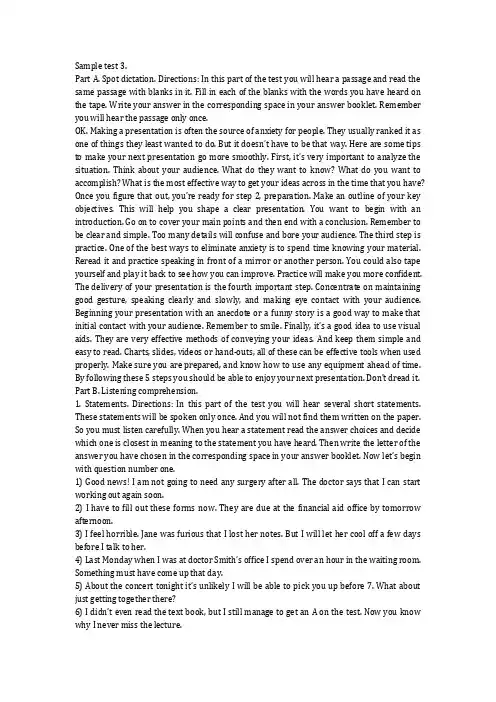
Sample test 3.Part A. Spot dictation. Directions: In this part of the test you will hear a passage and read the same passage with blanks in it. Fill in each of the blanks with the words you have heard on the tape. Write your answer in the corresponding space in your answer booklet. Remember you will hear the passage only once.OK. Making a presentation is often the source of anxiety for people. They usually ranked it as one of things they least wanted to do. But it doesn’t have to be that way. Here are some tips to make your next presentation go more smoothly. First, it’s very important to analyze the situation. Think about your audience. What do they want to know? What do you want to accomplish? What is the most effective way to get your ideas across in the time that you have? Once you figure that out, you’re ready for step 2, preparation. Make an outline of your key objectives. This will help you shape a clear presentation. You want to begin with an introduction. Go on to cover your main points and then end with a conclusion. Remember to be clear and simple. Too many details will confuse and bore your audience. The third step is practice. One of the best ways to eliminate anxiety is to spend time knowing your material. Reread it and practice speaking in front of a mirror or another person. You could also tape yourself and play it back to see how you can improve. Practice will make you more confident. The delivery of your presentation is the fourth important step. Concentrate on maintaining good gesture, speaking clearly and slowly, and making eye contact with your audience. Beginning your presentation with an anecdote or a funny story is a good way to make that initial contact with your audience. Remember to smile. Finally, it’s a good idea to use visual aids. They are very effective methods of conveying your ideas. And keep them simple and easy to read. Charts, slides, videos or hand-outs, all of these can be effective tools when used properly. Make sure you are prepared, and know how to use any equipment ahead of time. By following these 5 steps you should be able to enjoy your next presentation. Don’t dread it. Part B. Listening comprehension.1. Statements. Directions: In this part of the test you will hear several short statements. These statements will be spoken only once. And you will not find them written on the paper. So you must listen carefully. When you hear a statement read the answer choices and decide which one is closest in meaning to the statement you have heard. Then write the letter of the answer you have chosen in the corresponding space in your answer booklet. Now let’s begin with question number one.1) Good news! I am not going to need any surgery after all. The doctor says that I can start working out again soon.2) I have to fill out these forms now. They are due at the financial aid office by tomorrow afternoon.3) I feel horrible. Jane was furious that I lost her notes. But I will let her cool off a few days before I talk to her.4) Last Monday when I was at doctor Smith’s office I spend over an hour in the waiting room. Something must have come up that day.5) About the concert tonight it’s unlikely I will be able to pick you up before 7. What about just getting together there?6) I didn’t even read the text book, but I still manage to get an A on the test. Now you know why I never miss the lecture.7) I am going to be at a lecture in the auditorium most of this morning. And you know what the air-conditioning is like there. That’s why I am wearing this sweater.8) Did you go to the concert th e other day? It’s set a record for attendance. There wasn’t an empty seat in the house.9) The state ballet is coming to town next weekend and I just happen to have one ticket, but I got some sort of conflict in my schedule.10) How much longer should I boil these vegetables? They looked pretty done to me. The recipe says it needs only about 10 minutes total.2. Talks and conversations. Directions: In this part of the test you will hear several short talks and conversations. After each of these you will hear a few questions. Listen carefully because you will hear the talk or conversation and the questions only once. When you hear a question read the four answer choices and choose the best answer to that question. Then write the letter of the answer you have chosen in the corresponding space in your answer booklet.W: For the first time ever the scientific community has established the existence of planets outside their own solar system. Of course we knew that certain distance stars existed, but only recently did we learn that several of them are orbited by their own planets.M: Why did it take so long to locate these planets?W: You have to understand that they are a billion times dimmer than their parent stars. It will be like trying to see the light of a candle next to a huge explosion. We don't currently have a telescope that can be used to see them.M: But if the astronomers didn’t see the planets through a telescope how did they find them? W: By a very indirect method. The astronomers measured subtle distortions in the frequency of light from the parent stars, and observed that some of the stars seem to rock back and forth. They determined that this was caused by gravitational pull from orbiting planets.M: There is a powerful new telescope being built in Arizona. Will that help them see these planets?W: They should be but to see them at least at the form of small spot of light, and then the scientists will be able to break down and analyze this light. By doing this they hope to learn about the chemical composition of these planets, oxygen and ozone molecules, for example, would be tell-tale signs of life on these planets.M: I am looking forward to hearing more when the telescope is in operation. And I am sure our readers will be interested too.Questions:11) What is the purpose of this conversation?12) What is the conversation mainly about?13) How did the scientist establish the existence of the planets?14) According to the professor what might the scientists learn about the planets by using the new telescope?Questions 15 to 18 are based on the following talk.I am Frank. I am having some trouble with chemistry this year. It’s hard. The teacher acts like we are so smart that we ought to have no trouble learning it. I find the text book confusing and then I get discouraged. I can’t make sense of what the teacher saying in class.Well, some of us got together and formed the study group. It seems to work OK most of the time. We compare notes and then go over the discussion questions in each chapter. The only problem is that sometimes one of my friends will come to the study group unprepared. He will forget his notes or he won’t have read the book before hand. That really bothers me. I guess those guys who don’t prepare are going to have a h ard time in the final exam. Questions:15) Which of the following subjects is Frank having trouble with?16) Which of the following statements is not true as regards Frank’s difficulty with the subject?17) What’s the learning strategy Frank and his cl assmates are using?18) Which of the following statements is not true according to Frank?Questions 19 to 22 are based on the following 2 talks.M: I am Michael. I am trying to learn this new computer program at school. It’s kind of embarrassing. Most o f the other kids have already picked it up and I just can’t get it. There is this soft ware manual at school. I borrowed the book and took it home to read, but it didn’t seem to help. There were simply too much information for me to remember. My problem is that I don’t have enough time to sit down and learn it properly. I am not sure what to do next. W: I am Sonia. I am going to France next summer. So I want to learn as much French as I can. So I started taking a French class at the local community center. Well, the great thing is that the class is free. The problem is it’s not very easy. Well, you see it’s supposed to be a beginning level class. No way, I am telling you most of the people in there, they already know how to speak French when they started the class. They can say basic conversational phrases, and they know how to pronounce the words. I am a complete beginner. I did not know one word of French when I started this class. So I always feel lost even from day one I had no idea what was going on. Now the teacher is nice, but he is not very good. He gets off the topic and he will get stock on some tiny little point for like half an hour at time. But, you know, I really shouldn’t complain it at all, because this class is free.Questions:19) What is Michael trying to learn?20) Michael admits he had some problems. Which of the following is not one of the problems he mentions in his talk?21) Why is Sonia starting to learn French?22) Sonia mentions several problems for the French class she is attending. Which of the following is not one of these problems?Questions 23 to 30 are based on the following conversation.M: Hey, Louisiana/Rosana, over here!W: Hi, Mike. How are you? Been waiting long?M: No, not at all. Have a seat.W: Oh, it’s great to see you.M: Same here. So how is the new apartment working out?W: Good! Good! I like it. The neighborhood though is …M: Oh, what’s the matter?W: Well, there is real graffiti problem. Some of the buildings down the street are covered with it, and it looks terrible.M: I know what you mean. My neighborhood is the same way. I think we need to report people who are writing the graffiti to the police.W: Yeah, that would really help, except I never see them doing it.M: Well. Other than that how is the new neighborhood?W: Well, I like all the stores. It’s convenient for shopping. And it’s pretty quiet at night. That’s definitely a plus.M: Sounds like you are pretty satisfied.W: Yeah, I guess so. The only other problem is that it’s impossible to find parking. I have to drive around to block 6 or 7 times to find the space. Usually I can find one. But sometimes I have to park really far away.M: Well, is there any way you can rent space in the garage?W: Yeah, that’s a good idea. I am thinking ab out doing just that. So how are things in your neighborhoods?M: Well, there is a bit of noise problem where I live. I live down the street from a school. The bell rings every morning at 7:30. It’s impossible to sleep in.W: Oh, what a drag!M: Yeah. And when the school lets out kids are really noisy. I mean they are nice kids, just loud.W: Well, I don’t know what you could do about that situation.M: Yeah, there is really nothing I could do, I guess. I just have to live with it. I don’t know. Questions:23) Where are Mike and Louisiana/Rosana?24) Rosana mentions that her neighborhood has several features to recommend. Which of the following does Rosana not mention?25) According to the conversation there is one real problem in both the woman’s ne ighborhood and the man’s. Which is that problem?27) What’s the other problem that Rosana mentions about her neighborhood?28) What’s the problem with Mike’s neighborhood?29) Which of the following things causes the problem?30) What can Mike do about that situation?Part C. Listening and translation.1. Sentence translation. Directions: Listen and translate each sentence you have heard into Chinese. Then write it in the space given below.1) The internet is used by millions of people, which means that it is becoming a good way for companies to advertize and sell products.2) You should try out different kinds of food, within a few months you will have acquired a taste for many of the regional specialties.3) If I had been able to predict the future 2 years ago, I could have made a fortune for my stock investments.4) We carry over 30,000,000 passengers a year, and we fly to 41 destinations in 25 foreign countries. We are going to purchase new planes next year.5) The next item on the agenda is the new Spanish sales organization, as you know, we are going to open the new sales markets in March.2. Passage translation. Directions: Listen and translate each passage you have heard intoChinese. Then write it in the space given below. You may take notes while you are listening.1) Well, I have my own small business. I think all business owners especially small business owners have to be pretty creative. We have to do everything. I do the work, answer the phones, take care of the accounting, you know, there are so many potential problems and there is no one else to turn to. I mean I can’t ask my boss for help, I am the boss. The hardest part is figuring out how to identify your customers. Who are they? Where are they? How can you get to them?2) I am a n interior designer. So what I do is going to people’s homes and create a suitable environment for them. You know, my clients, they don’t know what they want. So I have to look at their homes and decide what will look best. Not every idea works in every home. You have to match the appropriate idea with the right place. After I come up with an idea I present it to my clients. Sometimes they don’t like my first idea, you have to start all over again.。
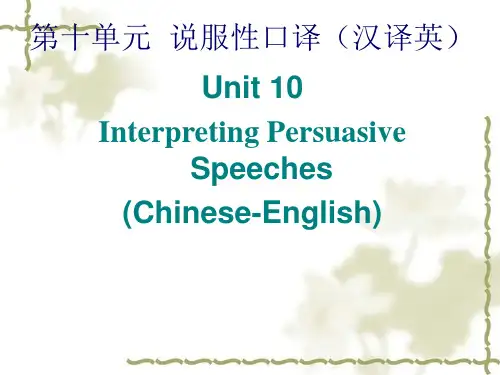
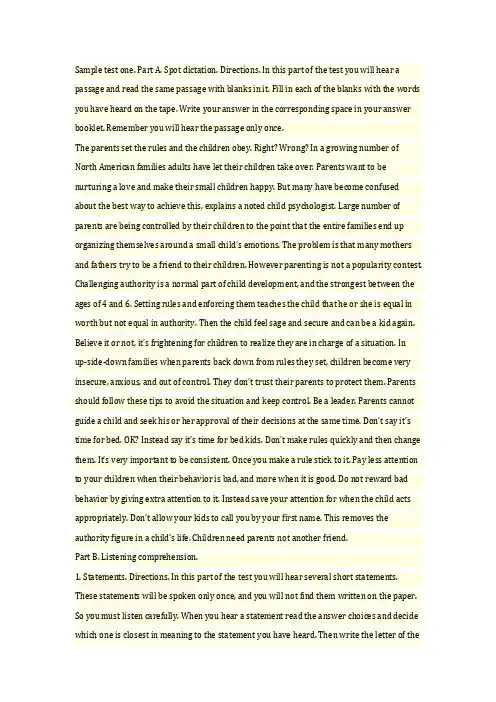
Sample test one. Part A. Spot dictation. Directions. In this part of the test you will hear a passage and read the same passage with blanks in it. Fill in each of the blanks with the words you have heard on the tape. Write your answer in the corresponding space in your answer booklet. Remember you will hear the passage only once.The parents set the rules and the children obey. Right? Wrong? In a growing number of North American families adults have let their children take over. Parents want to be nurturing a love and make their small children happy. But many have become confused about the best way to achieve this, explains a noted child psychologist. Large number of parents are being controlled by their children to the point that the entire families end up organizing themselves around a small child’s emotions. The problem is that many mothers and fathers try to be a friend to their children. However parenting is not a popularity contest. Challenging authority is a normal part of child development, and the strongest between the ages of 4 and 6. Setting rules and enforcing them teaches the child that he or she is equal in worth but not equal in authority. Then the child feel sage and secure and can be a kid again. Believe it or not, it’s frightening for childr en to realize they are in charge of a situation. Inup-side-down families when parents back down from rules they set, children become very insecure, anxious, and out of control. They don’t trust their parents to protect them. Parents should follow these tips to avoid the situation and keep control. Be a leader. Parents cannot guide a child and seek his or her approval of their decisions at the same time. Don’t say it’s time for bed. OK? Instead say it’s time for bed kids. Don’t make rules quickly and then c hange them. It’s very important to be consistent. Once you make a rule stick to it. Pay less attention to your children when their behavior is bad, and more when it is good. Do not reward bad behavior by giving extra attention to it. Instead save your attention for when the child acts appropriately. Don’t allow your kids to call you by your first name. This removes the authority figure in a child’s life. Children need parents not another friend.Part B. Listening comprehension.1. Statements. Directions. In this part of the test you will hear several short statements. These statements will be spoken only once, and you will not find them written on the paper. So you must listen carefully. When you hear a statement read the answer choices and decide which one is closest in meaning to the statement you have heard. Then write the letter of theanswer you have chosen in the corresponding space in your answer booklet. Now let’s begin with question number one.1) Do you think I could borrow your car to go grocery shopping? The supermarkets outside the city are so much cheaper than the one by the school.2) I got lost on my waited hotel in Boston last Sunday morning. I don’t know how I did it. I have been there a million times.3) Professor Avril sure was acting strangely in his morning class. He was talking so quietly and then not giving us any home work.4) I am sorry sir. But you are allowed only one piece of luggage on the plane. You will have to check one of the suit cases at the luggage counter.5) You wer en’t in class this morning. So you probably haven’t heard that the deadline has been extended a week.6) Are you going to the store? Well, I am low on laundry detergent, I forgot to buy some when I was at the supermarket yesterday afternoon.7) I just ca lled the travel agent. It’s all set. In the first week of next month, I am heading for the beach for an entire week.8) I worked very hard on my research paper. But the professor said that I made many broad claims that won’t support it enough.9) You say you really like those abstract paintings we saw in our art history class today, but I guess it’s something I haven’t acquired a taste for yet.10) You will be staying at the Hilton, right across the street from the conference center. But I am at the Royal Hotel 6 miles away.中级口译听力教程第三版8AAn intermediate course of English listening. Third edition.Sample test one.Part B. Listening comprehension. 2. Talks and conversations. Directions: In this part of the test you will hear several short talks and conversations. After each of these you will hear a few questions. Listen carefully because you will hear the talk or conversation and the questions only once. When you hear a question, read the four answer choices and choose the best answer to that question. Then write the letter of the answer you have chosen in the corresponding space in your answer booklet.Questions 11 to 14 are based on the following talk.Community service is an important component of education here at our university. We encourage all students to volunteer for at least one community activity before they graduate.A new community program called one-on-one helps elementary students who fallen behind. You education majors might be especially interested in it, because it offers the opportunity to do some teaching, that is tutoring in math and English. You’d have to volunteer 2 hours a week for one semester. You can choose to help a child with math, English, or both. Half hour lessons are fine, so you could do a half hour of each subject 2 days a week. Professor Doge will act as mentor to the tutors. He will be available to help you with lesson plans or to offer suggestions for activities. He has office hours every Tuesday and Thursday afternoon. You can sign up for the program with him and begin the tutoring next week. I am sure you will enjoy this community service and you will gain valuable experience at the same time. It looks good on your resume too, showing that you had experience with children, and that you care about your community. If you like to sign up or if you have any questions stop by professor Doge’s office this week.Questions:11) What is the purpose of this talk?12) What is the purpose of the program described by the man?13) What does professor Doge do?14) What should students interested in the tutorial do?Questions 15 to 21 are based on the following 2 talks.W: Well, I went away to college when I was 17. I had never lived away from my parents before. And I was really looking forward to it. But I was also scared because I was leaving my friends behind. And I didn’t know anyone when I first arrived. I lived in a really big dormitory and shared a room with 2 other girls. I guess the thing I learn the most was how to get long with others. You know how to respect other peo ple’s opinions and properties, stuff like that. At home I don’t always have my own room. This was the first time I’d have to live with other people in the same room. We were all really different. I mean our personalities and life styles were completely opposite in some ways. Anyway, at first it really caused problems, but we learned how to get along living in those tight cordors, three 17 years olds live in one room. Can you imagine? I am surprised we survived at all.M: I think for myself. The hardest thing was learning how to manage my own time better. I used to stay up late watching TV a lot, didn’t eat well, often went to class unprepared, and things like that. My grades were really suffering, and I could hardly keep my eyes open in class. It was a drag. Somehow, midway through the semester, I changed and started to do well. Organizing my time was a real challenge. In high school I didn’t have to worry. I had the same schedule everyday. And at night my parents were pushing me to study. But it’s different when you go away to college. You have to learn to take responsibility for your actions. No one is going to tell you what to do. You have to figure it out for yourself.Questions:15) How old was the woman when she went away to college?16) Why did she feel scared when she first arrived at the college?17) The women mentions that she learned several things at college, which of the following is not one of these things?18) Which was the most difficult thing for the man when he went away to college?19) Which of the following statements is not true as to his performance when he first arrived at college?20) When did he change and start to improve?21) According to the man what’s the thing you have to learn when you go away to college? Questions 22 to 26 are based on the following conversation.M: I just found out that my parents are moving.W: Mm, are you surprised?M: Well, not really. They’ve been trying to sell their house for 6 months to a year now.W: Oh, well, I thought they liked where they were.M: They do. They love it. But they are getting older. Dad wants to live in a smaller town. And mom says she is sick and tired of the fast pace and taking care of the house, you know.W: Mm. So where are they going to move?M: I can not believe this.W: What?M: They are going to Mexico. Can you believe it?W: Oh, my Gosh. You are kidding.M: Nope. They are going to San Miguel De Olanda. It’s a gorgeous little town in mountains. W: Wow, I have never heard of it.M: It’s about 115 miles northwe st of Mexico city.W: Wow, do your parents speak Spanish?M: No, but they are going to learn.W: Wow, that is a big change. Why don’t they stay in the US?M: Well, they always want to live abroad. Now that they are retired they finally get to do it. And my dad, he adores Mexico. He has been there 6 or 7 times at least.W: Wow, sounds like this is going to be quite an adventure.M: It should be. In San Miguel it is stunning. The government has made sure that there are no new buildings ever built there. So that the traditional feeling of the town. Wow, it’s been preserved. Oh, and they made pottery there, which is perfect for my mother, because she collects the stuff.W: Oh, that’s great for her. So I guess now you are going to have a place to stay in M exico. M: Yeah.W: And a place for your friends to come and visit in Mexico.M: Well, if my friends are nice to me, I suppose something could be arranged. Did you have anybody in particular in mind?W: Oh, very funny. So when exactly are they moving?M: In a couple of months. They have to pack up and take care of all the business here. I am going to help them with the move. I may even try to stay a couple of months if I can swing the time.Questions:22) Why is the man not really surprised at his par ents’ moving?23) The man mentions several reasons to explain why his parents are moving, which of the following is not one of the reasons?24) Where his parents planning to move?25) According to the conversation which of the following statement is not true?26) When exactly are they moving?Questions 27 to 30 are based on the following talk.OK. Let’s talk a little bit today about Steve Jobs, founder of Apple Computer. Jobs, a college drop out, a drop out who then goes on to start a revolutionary computer company, that changed the way the world perceive the computer and its role in society. Steve jobs believed, I should say strongly believed that the computer should and would become a tool for the everyday person. In his own words, he says, quote, we started it out to get a computer in the hands of everyday people. And we succeeded beyond the wildest dreams. And succeed he did, in 1977 the world’s first mass marketed personal computer, the apple two, came out. Hundreds and hundreds of thousands were sold. Other companies sprang up. And by 1985 there were 38 million computers in the world. In the year 2000, that number climbed to 557 million. In millions of homes across the globe, we communicate by computer, we play games, we get and give information, we shop, we work, we organize our personal finances, all done on a personal everyday home computer. Now behind Jobs’ belief that the computer should made available to the everyday person, was a true underlined belief in technology, that technology could be used to better our lives. The seventies saw real revolution in technology, but people like Steve Jobs were motivated by more than just the need to be involved in the technological revolution. He wanted to shape it. Jobs believed that it’s important to comb ine technology and art to be creative. With this kind of thinking it’s not too surprising to see why the macintosh has become a favorite among artists, graphic designers, professionals in the publishing and video and animation industries. Jobs says, quote, the macintosh turned out so well because the people working on it were musicians, artists, poets, and historians, who also happen to be excellent computer scientists. So Jobs believed in technology. He believed it could be made available to everyone, and he believed that it could be used as a tool for creativity. He was certainly a pioneer.Questions:27) Which of the following statements is not true about Steve Jobs?28) In which year was the first mass marketed personal computer produced?29) How many computers were there in the world in the year of 2000?30) What was Steve Jobs true underlined belief?Part C. Listening and translation.1. Sentence translation. Directions: Listen and translate each sentence you have heard into Chinese. Then write it in the space given below.1) It’s very difficult to quit smoking, which is why it is better not to start smoking in the first place. Doctors often say smoking kills.2) Most of the people I know are interested in the proposed tax reform being debated in the congress. Because they hope it will lower taxes for them.3) If more companies provide child’s care facilities at work, they will really help mothers who had to work outside of their homes.4) You shouldn’t be worried about making new friends. It w ill happen gradually. By this time next year I am sure you will have made many new friends5) There are more high school drop outs than before. Thus there are more unqualified young people looking for jobs than there used to be.2. Passage translation. Directions: Listen and translate each passage you have heard intoChinese. Then write it in the space given below. You may take notes while you are listening.1) You know the one issue that I feel the strongest about is the environment. Well, maybe it’sa little bit expensive to change our ways, but we have to try. We need to take care of the world we live in. So I think we can all do small things like recycle plastics and be careful not to waste water and electricity. You know what they say. We only have one world so we shouldn’t mess it up.2) For me freedom speech is very important. We should always be allowed to say what we believe, especially now. You know that people want to send to the internet, they want to limit what we have access to our computers. Well, I don’t agree with that at all. Of course I know it’s a tricky question, where do you draw the line on what should be controlled? What limit should be placed on our freedom of speech? I suppose there have to be some limits set, but I say the fewer the better. Maybe the best thing is just set aside everything on a case by case bases.。
沪江英语绿宝书之2011年3月上海中级口译考试听力原文及解析SECTION 1: LISTENING TEST (45 minutes)Part A: Spot DictationDirections:In this part of the test, you will hear a passage and read the same passage with blanks in it. Fill in each of the blanks with the word or words you have heard on the tape. Write your answer in the corresponding space in your ANSWER BOOKLET. Remember you will hear the passage ONLY ONCE.My topic for today‟s lecture is communication, culture and work. When most people use the word culture, they think of people from different national backgrounds. National cultures certainly do exist and they play an important role in shaping the way people communicate, but there are other dimensions of culture too. Within a nation, regional differences can exert a powerful influence on communication. New Yorkers and Alaskans may find one another‟s styles of behaving so different that they might as well be from different countries. Race and ethnicity can also shape behavior. So can age. The customs, values and attitudes of a twenty-year-old girl may vary radically from those of her parents who were raised in the 1960s or her grandparents who lived through the Great Depression and World War Ⅱ. Still, other differences can create distinctive cultures. Gender, sexual orientation, physical disabilities, religion and socio-economic background are just a few. All of these factors lead to a definition of culture as a set of values, beliefs, norms, customs, rules and codes that lead people to define themselves as a distinct group, giving them a sense of commonality. It‟s important to realize that culture is learned, not innate.A Korean-born infant adopted soon after her birth by American parents and raised in the United States will think and act differently than his or her cousins who grew up in Seoul. An African American who grew up in the inner city will view the world differently than he or she would if raised in the suburbs or in a country like France where African heritage has different significance than it does in the United States. The norms and values we learn as part of our cultural conditioning shape the way we view the world and the way we interact with one another. In short, culture has such an overwhelming influence on communication that famous anthropologist Edward Hall once remarked, …culture is communication and communication is culture.‟【解析】作为中口笔试听力第一题Spot Dictation,考试选用了文化题材的内容,考生对此类型题材应该并不陌生,但若不集中注意力,也会比较难把握文章的层次。
第一篇强市之路The Road to a Prosperous Cityarticulate 阐明agenda 一切工作lifeblood 生命线multifaceted 系统工程disruptive破坏性的indulgence 不介意highlight 着重insurer 保险公司license 获准sell policies 出售保单securities 证券virtuous cycle 良性发展local supplier 本地供应商cluster of innovation 创新产业聚焦地development patent 开发性专利venture capital 风险投资foresighted example 破有远见的例子advisory council 咨询会议underpinning 基石educated citizenry 受过良好教育的公民curriculum 课程interdisciplinary 跨学科scholarship 研究virtual world 虚拟世界nurture 指导internship实习mentoring 传、帮、带role model 榜样的示范作用rationalize 完善regulatory environment 法制环境stifle扼杀enlightened 宽松开明accompanying disruption 伴随的冲击secure one's position 必将成为市长先生,首先感谢您给我这个机会来谈一下我对上海如何才能成为21世纪世界主要创新中心之一的看法。
Mr.Mayor, Let me thank you for the opportunity to share some thoughts about how to ensure Shanghai’s place as one of the world’s leading centers of innovation in the 21st century.毫无疑问,市长先生已经意识到创新对于上海经济发展和繁荣的重要意义。
上海中级口译培训的课程笔记整理2021.11.23一、句型(顺译法)1、我不想陪你看电影了,请原谅。
I’d rather not go to the cinema with you if you don’t mind.2、在该合同的有效期内,双方必须严格遵守。
During the period of the agreement, both the parties should abide by the terms and conditions of this agreement.3、两个星期以前,中国在世界经济强国排名是第十位,这个星期排第三名列美日之后; Tow weeks ago, China had the tenth largest economic country in the world, this week it jumps to the third behind the US. and Japan; 印度从前是11名,现越上了第六名; India formerly No.11 leaps to No.6; 墨西哥从第12位上升到第10位。
Mexico climbs from No.12 to No.10.4、爸爸比我妈妈大好多岁,他死了后过了6个月我才出生。
He was much older than my mother when he married and dead 6 month before I was born.5、奶奶一直不理我爸爸,因为她觉得他不该去娶这么年轻的老婆。
Grandma has not spoken to my father since his marriage, because she considered he had made a mistake in marrying young girl.6、记得那天,冷风习习,是3月的一个星期五下午。
It’s a cold, windy, Friday afternoon in Mar ch.7、我晓得我像个孩子,我晓得我太小了,当你的太太不够格,我太小了,不能当一个贤妻良母。
上海中级口译考试全攻略上海中级口译考试全攻略(笔试+口试)两周前风尘仆仆地考完中级口译,常有人问我考得怎么样。
我的答复总是:美女很多+非常紧张。
在参加考试之前,我常听到两种说法:中级口译太简单了,根本是没用的证,不如去考高口;中级口译太难了,只有高手才能拿到证。
这两种说法都没错,对不同英语程度的人来说,中级口译的地位也不尽相同。
我当初想到考中级口译并不是为了那一纸证书,因为我对于口译兴趣很小。
想到报名完全是为了提高听力。
上海交大去年做的一项调查显示,65%的同学认为经过口译训练,听力水平得到了大幅提高。
当时我在《外国语》上看到这篇论文,立刻想到通过中级口译提高我可怜的听力。
复习之后我还发现,口译对拓宽词汇量尤其是生活词汇作用巨大。
下面我就来谈谈怎么准备中级口译。
首先你需要买中级口译的教材,一共五本通过笔试。
一旦通过笔试,你就获得了接下来四次参加口试的机会(即两年有效期),我推荐在9月参加笔试,因为暑假时间较多,而寒假有春节的干扰,复习不充分,很多人都会放弃3月的考试。
下面我简要介绍一下中级口译的考试内容及复习方法。
笔试部分共三部分,即听力、阅读和笔译。
听力占90分,包含听写填空,段对话及长对话,听译。
听写填空,英文叫spot dictitation, 给400词左右的文章,抠去20个空,每个空需要填进去1~4个单词,文章只读一遍。
这部分最重要的就是练习和预测了。
反复的练习能够迅速提高正确率,而做这一题型的技巧就是预测。
拿到一份试题,迅速阅读这篇文章,预测每一个空的词性和含义,最容易做错或漏听的是两个空格靠得很近的时候以及空格在一行行首的时候,在这时就要提前标出这些空,重点关注。
短对话和长对话也很容易短期提高。
这部分只有选项没有问题,每一段对话只读一遍,结束的时候会在录音中给出问题,我做这一题的经验就是:记笔记。
当然,录音开始之前可以根据选项预测对话内容,然后在听的过程中尽量记下讯息(尤其是与选项有关的问题),在自己复习的过程中,可以总结对话类型,比如有“男生死都会去”类型(即男生怎么样都会不学习出去玩),还有“女生死都不会去”类型(即女生怎么样都不会不学习)……听译是很多人头痛的部分。
《中级口译教程》学习重点2—1 Greetings at the Airport 机场迎宾1. 人力资源部经理Manager of Human Resources Division2。
top—notch 顶尖的/拔尖的notch: 槽口/ 凹口3. 百忙中抽空take time from one’s busy schedule4. run into a strom 撞上/偶遇风暴run into=run across=meet sb/sth accidently=by chanve=unexpectedly5. 倒时差to get over the jet-lag6. 设宴洗尘to hold a reception party in one’s honor7.典型的中国杂技a typical Chinese acrobatic show8.集团总裁Chairman of the Board2-2 Hotel Accommodation 宾馆入住1. 旅行社travel agency/travel service2。
itinerary 路线/旅行预定路线 a route or proposed route of a journey3。
豪华套房deluxe/luxury suite4。
8折优惠价 a good rate with 20% off5. 总台Front Desk6。
餐饮部Catering Service7. 洗熨部Laundry Service2—3 Banquet Service1.满足客人的不同需求:cater to the different needs of our guests2。
敬业的专家:dedicated experts3。
没有她的最后努力,还不知道现在会怎么样呢:Without her last—minute effort, we would still be in the middle of nowhere。
竭诚为您提供优质文档/双击可除上海中级口译笔试教材篇一:上海中级口译口试中出现的教材原题中口口试中出现的《中级口译教程》上的内容第二单元2-2:宾馆入住2-4:参观访问第三单元3-1:欢迎光临3-2:投资意向3-3:合资企业3-4:文化差异第四单元4-2:话说口译4-3:经营之道第五单元5-1:故地重游第六单元6-1:新春联欢6-3:开幕祝词第七单元7-1:大学介绍20xx.05.08上午20xx.11.28上午20xx.11.21下午20xx.05.20下午(改编)20xx.11.21下午20xx.11.13下午20xx.11.28上午20xx.11.09下午20xx.11.04下午20xx.11.10下午20xx.05.06下午20xx20xx.05.05上午20xx.11.16上午(注:以第四版教程为准)7-3:浪漫香槟7-4:教堂之游第八单元8-1:丝绸之路8-2:传统节日8-3:教育之本第九单元9-1:强市之路9-2:家庭责任9-3:大学精神第十单元10-2:环境保护第十一单元11-4:股票市场第十二单元12-4:社区服务第十三单元13-1:企业文化13-3:硅谷之贵20xx.05.06下午20xx.05.20下午20xx.11.2720xx.11.04下午20xx.05.27下午20xx.11.20下午20xx.04.29下午20xx.11.09上午20xx.11.20上午20xx.05.20下午(改编)20xx.05.10上午20xx.11.26下午20xx.11.28下午20xx.11.08上午第十四单元14-1:双边经贸(注:其中有关中美关系的话题曾在20xx.5.15、20xx.5.22、20xx.11.13、20xx.11.20考过多次,应该是教材中几篇课文的重组,与中美关系有关的课文有3-4:文化差异、14-1:双边经贸。
此外,改革开放也考过多次,14-4:经济合作有一部分是改革开放的话题。